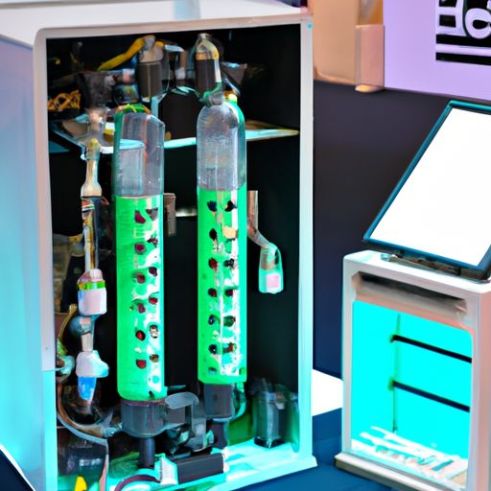Table of Contents
وقود الهيدروجين المبرد بالماء

التكنولوجيا الجديدة لخلايا الوقود الهيدروجينية
اكتسبت تكنولوجيا خلايا الوقود الهيدروجينية المزيد من الاهتمام في السنوات الأخيرة كبديل نظيف وفعال للوقود الأحفوري التقليدي. أحد أحدث التطورات في هذا المجال هو تطوير خلايا وقود الهيدروجين المبردة بالماء، والتي توفر أداءً ومتانة محسنين مقارنة بالأنظمة المبردة بالهواء.
تعمل خلايا وقود الهيدروجين المبردة بالماء باستخدام الماء كمبرد لتنظيم درجة حرارة كومة خلية الوقود. ويساعد ذلك في الحفاظ على ظروف التشغيل المثالية ومنع ارتفاع درجة الحرارة، مما قد يقلل من الكفاءة ويقصر من عمر خلية الوقود. من خلال تدوير الماء عبر النظام، يتم تبديد الحرارة بشكل أكثر فعالية، مما يسمح لخلية الوقود بالعمل بمستويات طاقة أعلى لفترات أطول من الوقت.
بالإضافة إلى الإدارة الحرارية المحسنة، توفر خلايا وقود الهيدروجين المبردة بالماء أيضًا فوائد أخرى مثل: زيادة كثافة الطاقة والموثوقية. يسمح استخدام الماء كمبرد بتصميمات أكثر إحكاما وخفيفة الوزن، مما يجعلها مثالية لمجموعة واسعة من التطبيقات بما في ذلك توليد الطاقة الثابتة والنقل والإلكترونيات المحمولة. علاوة على ذلك، فإن خلايا الوقود المبردة بالماء أقل عرضة للتدهور وفقدان الأداء بمرور الوقت، مما يؤدي إلى عمر خدمة أطول وانخفاض تكاليف الصيانة.
الميزة الرئيسية الأخرى لخلايا وقود الهيدروجين المبردة بالماء هي قدرتها على العمل في درجات حرارة أعلى دون المساس أداء. وهذا مهم بشكل خاص في ظروف الطقس البارد، حيث قد تواجه أنظمة تبريد الهواء صعوبة في الحفاظ على درجات حرارة التشغيل المثلى. باستخدام الماء كمبرد، يمكن لخلايا الوقود الحفاظ على أداء ثابت حتى في البيئات القاسية، مما يجعلها أكثر تنوعًا وموثوقية لمجموعة متنوعة من التطبيقات.
يمثل تطوير خلايا وقود الهيدروجين المبردة بالماء خطوة مهمة إلى الأمام في تقدم تكنولوجيا خلايا الوقود. ومن خلال معالجة التحديات الرئيسية مثل الإدارة الحرارية والموثوقية، توفر هذه الأنظمة بديلاً أكثر كفاءة واستدامة لطرق توليد الطاقة التقليدية. مع استمرار تزايد الطلب على حلول الطاقة النظيفة، تستعد خلايا الوقود المبردة بالماء للعب دور حاسم في تلبية احتياجات العالم من الطاقة مع تقليل انبعاثات الكربون والأثر البيئي.
في الختام، تمثل خلايا الوقود الهيدروجينية المبردة بالماء تقنية جديدة واعدة توفر أداءً وموثوقية وكفاءة محسنة مقارنة بأنظمة تبريد الهواء. بفضل قدرتها على العمل في درجات حرارة أعلى، والحفاظ على إنتاج طاقة ثابت، وتقليل تكاليف الصيانة، فإن خلايا الوقود هذه مناسبة تمامًا لمجموعة واسعة من التطبيقات في مختلف الصناعات. ومع استمرار تقدم البحث والتطوير في هذا المجال، من المتوقع أن تلعب خلايا الوقود الهيدروجيني المبردة بالماء دورًا رئيسيًا في الانتقال إلى مستقبل طاقة أكثر استدامة وصديقة للبيئة.
Hydrogen Fuel Cell New Technology
Hydrogen fuel cell technology has been gaining traction in recent years as a clean and efficient alternative to traditional fossil fuels. One of the latest advancements in this field is the development of water-cooled hydrogen fuel cells, which offer improved performance and durability compared to air-cooled systems.
Water-cooled hydrogen fuel cells work by using water as a coolant to regulate the temperature of the fuel cell stack. This helps to maintain optimal operating conditions and prevent overheating, which can reduce efficiency and shorten the lifespan of the fuel cell. By circulating water through the system, heat is dissipated more effectively, allowing the fuel cell to operate at higher power Levels for longer periods of time.
In addition to improved thermal management, water-cooled hydrogen fuel cells also offer other benefits such as increased power density and reliability. The use of water as a coolant allows for more compact and lightweight designs, making them ideal for a wide range of applications including stationary power generation, transportation, and portable electronics. Furthermore, water-cooled fuel cells are less prone to degradation and performance loss over time, resulting in longer service life and lower maintenance costs.
Another key advantage of water-cooled hydrogen fuel cells is their ability to operate at higher temperatures without compromising performance. This is particularly important in cold weather conditions, where air-cooled systems may struggle to maintain optimal operating temperatures. By using water as a coolant, fuel cells can maintain consistent performance even in extreme environments, making them more versatile and reliable for a variety of applications.
The development of water-cooled hydrogen fuel cells represents a significant step forward in the advancement of fuel cell technology. By addressing key challenges such as thermal management and reliability, these systems offer a more efficient and sustainable alternative to traditional power generation methods. As the demand for clean energy solutions continues to grow, water-cooled fuel cells are poised to play a crucial role in meeting the world’s energy needs while reducing carbon emissions and environmental impact.
In conclusion, water-cooled hydrogen fuel cells represent a promising new technology that offers improved performance, reliability, and efficiency compared to air-cooled systems. With their ability to operate at higher temperatures, maintain consistent power output, and reduce maintenance costs, these fuel cells are well-suited for a wide range of applications in various industries. As research and development in this field continue to progress, water-cooled hydrogen fuel cells are expected to play a key role in the transition to a more sustainable and environmentally friendly energy future.
